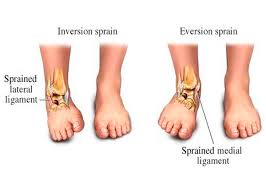 Ankle sprains are the most common injury of the lower extremity, affecting a large percentage of the sporting population, especially those participating in contact and collision sports such as basketball, football and soccer. Ankle sprains are especially prevalent in younger athletes, with the greatest incidence of injury occurring duringthe mid to late teen years. Ankle sprains are commonly underestimated regarding the functional restrictions that take place and the long-term negative effects that can occur among those affected. Recurrence of ankle sprains is estimated to be as high as 40-70%, especially among individuals participating in higher risk sports. Long-term negative effects can include need for surgical repair of damaged ligaments, and cartilage damage, also known as osteoarthritis. Clearly, the mindset of an ankle injury as “just a sprain” needs to be reconsidered.
Ankle sprains are the most common injury of the lower extremity, affecting a large percentage of the sporting population, especially those participating in contact and collision sports such as basketball, football and soccer. Ankle sprains are especially prevalent in younger athletes, with the greatest incidence of injury occurring duringthe mid to late teen years. Ankle sprains are commonly underestimated regarding the functional restrictions that take place and the long-term negative effects that can occur among those affected. Recurrence of ankle sprains is estimated to be as high as 40-70%, especially among individuals participating in higher risk sports. Long-term negative effects can include need for surgical repair of damaged ligaments, and cartilage damage, also known as osteoarthritis. Clearly, the mindset of an ankle injury as “just a sprain” needs to be reconsidered.
Fortunately, physical therapy has been shown to be effective in reducing the pain and limited function that result from ankle sprains. Also demonstrated in various research studies,is the finding that guided exercise and manual therapyprovided by a physical therapist can reduce the risk of recurrent ankle sprains.
Ankle sprains can be classified by the specific anatomical structures involved. Lateral sprains involve the lateral, or outside, ligaments of the ankle, most commonly the anterior talofibular, the calcaneofibular, and occasionally the posterior talofibular ligaments. They typically result from an inversion, or rolling inward of the foot on the lower leg. Medial sprains involve the medial, or inner, deltoid ligament, and usually result from an outward movement of the foot on the lower leg. Less frequently, but considered more disabling, is the “high” sprain, typically involving the proximal tibiofibular ligament. High ankle sprains are commonly associated with the planted foot being rotated outward in relation to the lower leg, and less commonly with hyper-dorsiflexion of the ankle (foot being forcibly pushed upward on the lower leg). Sprains are also classified according to severity of ligament damage. Grade I sprains are considered mild and involve microscopic tearing of ligamentous structures. Grade II sprains are more severe and involve partial tearing of the ligaments and result in increased laxity, or permanent stretching of the ligament. Grade III sprains are considered complete tears to the ligaments and result in major laxity of the ankle joint.
Recurrence of ankle sprains is a significant concern, resulting in lost playing time among athletes. Cartilage damage has also been shown to occur in some individuals suffering from chronic ankle instability (CAI). CAI is likely a result of weakness of the musculature surrounding the ankle, as well as a decreased sense of proprioception, or the ability of the body to detect position and changes in position of the body, or limb, in space. Fortunately, both weakness of the ankle musculature and decreased proprioception have been shown to be positively affected by physical therapy intervention. Guided exercises targeting the ankle musculature, especially the lateral muscles (peroneals), can help increase dynamic ankle stability. Various methods of strengthening are available, such as manual resisted exercise, elastic band and tubing exercise, and various machine resisted exercise.
Proprioceptive exercises are also critical in helping to reduce the recurrence rate of ankle sprains. Proprioception is dependent on specialized nerve endings that are located in the ligaments, joint capsules, skin and muscles of our body. Our sense of proprioception has been shown to be deficient following injury or surgery, and the resulting deficit is thought to play a significant role in re-injury. Exercise placing a demand on our ability to maintain positions underdifferent challenges has been shown in numerous studies to help improve our sense of proprioception, and thus reduce the risk of recurrent ankle sprains. Proprioceptive exercises can include the use of unstable surfaces, such as balance boards, BOSU trainers and foam (AIREX) pads. Proprioceptive deficits can also be addressed by dynamic exercises on a stable surface, including single leg balance drills involving movement of the body, such as resisted elastic band movements or ball kicking and throwing. Also important to consider are other challenges, such as performing balance exercises with the eyes closed, placing a greater stress on the proprioceptive system.
For those individuals experiencing an initial ankle sprain, or those suffering from chronic ankle instability, physical therapy can play a vital role in reducing pain and risk of recurrence, as well as improving ankle joint stiffness, strength and function. Avoid the faulty notion that ankle sprains are “just a sprain”, and consult your physical therapist to optimize your recovery.
Bill Kosik, MSPT, OCS, ATC, Cert. MDT, CSCS and Marley Kosik

